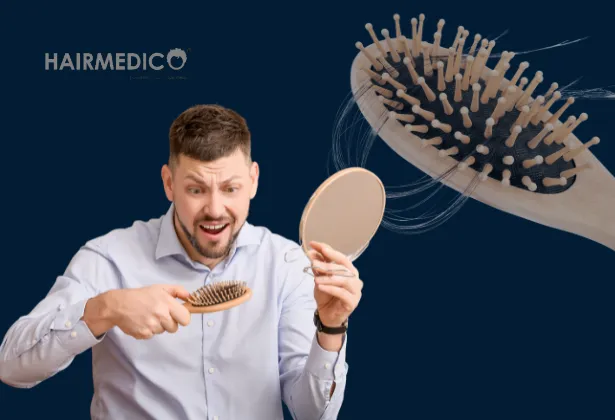
Hair loss affects millions of men worldwide, and understanding its progression is essential for choosing the right treatment options. The Norwood Scale, also known as the Hamilton-Norwood Scale, is the most commonly used classification system for measuring the severity of male pattern baldness (androgenetic alopecia).
This guide covers:
For expert guidance, book a free consultation at Hairmedico.
The Norwood Scale is a classification system that helps diagnose and track the progression of male pattern baldness. It is divided into seven stages, ranging from minimal thinning to complete baldness.
Doctors and hair restoration specialists use this scale to:
Understanding your Norwood stage can help you make informed decisions about hair restoration.
There is no visible hairline recession or thinning. Hair appears full and healthy. No treatment is necessary, but maintaining a balanced diet and hair care routine can help prevent future hair loss.
A minor recession occurs in the temple area, but there is no significant thinning on the top of the scalp. Preventive treatments like Minoxidil (Rogaine) or Finasteride (Propecia) may be effective at this stage. PRP therapy can also strengthen hair follicles.
The hairline moves deeper into the scalp, often forming an M-shape pattern. Some hair thinning may begin at the crown. Treatment options include Minoxidil, Finasteride, PRP therapy, or, in some cases, a hair transplant.
Hair loss is more advanced, with deeper recession at the temples and noticeable thinning at the crown. A hair transplant (FUE or DHI) is often recommended at this stage. PRP therapy and scalp micropigmentation can also help improve appearance.
The bald areas at the front and crown are larger, with only a thin bridge of hair between them. Hair transplant procedures such as Sapphire FUE or DHI are commonly used to restore density.
The bridge of hair between the front and crown disappears, leaving a large bald area. A mega-session hair transplant may be needed, using 4,000+ grafts for maximum coverage. If the donor area is weak, body hair transplant (BHT) may be considered.
Very little to no hair remains on the scalp. Hair transplant may still be possible using body or beard hair. Alternatively, scalp micropigmentation provides a non-surgical solution for a shaved-head appearance.
To determine your Norwood stage and explore treatment options, schedule a consultation with Hairmedico.
| Norwood Stage | Recommended Treatments |
|---|---|
| Stage 1-2 | Preventive care, Minoxidil, Finasteride |
| Stage 3-4 | PRP Therapy, Hair Transplant (FUE/DHI) |
| Stage 5-6 | FUE/Sapphire FUE, Combination Therapy |
| Stage 7 | BHT, SMP, or Non-Surgical Solutions |
For more details, visit Hairmedico.
A hair transplant is ideal for individuals in Norwood Stages 3-6, when hair loss is more visible and progressive. Signs that you may need a hair transplant include:
A consultation with a specialist at Hairmedico can help determine if a hair transplant is the right solution for you.
For more information on post-transplant care and hair maintenance, visit Hairmedico.
If you are experiencing hair loss, do not wait for it to worsen. Identify your Norwood stage and book a consultation with Hairmedico to explore your hair restoration options.